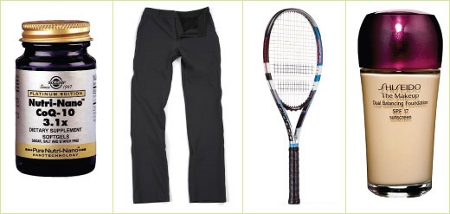Feature: Peril in Small Places

More and more consumer products are being developed using super-small nanoparticles, but is it safe? — A cover story from the November 2010 issue of Prism magazine by Corinna Wu.
What dangers lurk in our expanding use of nanotechnology?
Advertisers have always lured consumers with promises of the latest technology. Nowadays, the terms “space-age” and “new-and-improved” have given way to “nano.” An ad for a cutting board boasts that its “surface with nano-silver coating protects sliced food from bacteria and germs.” A line of cookware features “a revolutionary and technologically advanced ceramic non-stick Nano-GlazeTM on the inside and outside of every vessel.” Shampoo is “luxuriously enriched with light-weight ingredients and leverages the latest molecular nanotechnology.”
More than 1,000 consumer products now use nanotechnology – a $254 billion market in 2009 – and that number could grow 10-fold in the next decade, researchers say. Global research and development in the field have already garnered 4,000 patents. What some call an investment “gold rush” will reach $1 trillion by 2015, according to the International Center for Technology Assessment. Numerous medical products using nanotechnology have been commercialized. Nanotechnology in various uses is showing up around the world in manufacturing, oil fields, military installations, and private homes. It holds the promise of cleaner energy, cleaner water, and biomedical advances. Indeed, it’s well on the way to becoming a “general-purpose technology,” according to a recent report issued by the World Technology Evaluation Center Inc.

The wonder of nanotechnology is the abundance of materials, devices, and systems made possible by controlling and manipulating matter at the atomic and molecular levels. But with that wonder comes concern that these now ubiquitous nanoparticles could spread new hazardous pollutants that threaten health and the environment. “We’re trying to say, ‘These are new materials. We don’t know if there’s a problem, so let’s ask now,’” says Sally Tinkle, senior science adviser at the National Institute for Environmental Health Sciences, part of the National Institutes of Health. With prodding from the National Research Council and other institutions, inquiry into the health and environmental effects of nanotechnology has gone hand in hand with research on potential applications. The work is interdisciplinary, and engineers play a critical role. By helping to figure out what makes a nanoparticle toxic, they can, for instance, design nanoparticles that kill cancer cells yet don’t harm healthy tissues, or that remove pollutants from soil without poisoning wildlife.
So far, engineered nanomaterials (ENM) are not known to have caused any disease or serious environmental hazard, according to a presentation earlier this year by Andre Nel of the University of California-Los Angeles Medical School and David Grainger of the University of Utah. “However, there is experimental evidence of ENM hazard,” they reported.
Read more from the Prism article here.
Filed under: Special Features








